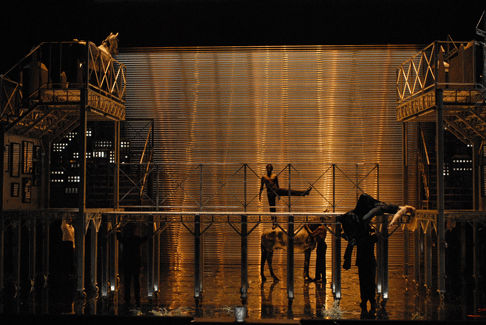19 Jul 2009
Mozart Mistreated at Aix-en-Provence Festival
At the festival of Aix-en-Provence, now in its sixty-first year, the final installment of Wagner’s “Ring,” with Simon Rattle and the Berlin Philharmonic, has hogged the spotlight.

At the festival of Aix-en-Provence, now in its sixty-first year, the final installment of Wagner’s “Ring,” with Simon Rattle and the Berlin Philharmonic, has hogged the spotlight.
Nevertheless, Mozart has always been the core of the Festival repertory and the new production of “Idomeneo” did look good on paper. The opera has 6 performances, from July 4 through 17, in the traditional venue, the courtyard of the Archbishop’s palace in Aix.
Director Olivier Py has been heaped with praise for his work with Geneva’s opera for the past several years. Recently appointed to head the top Odéon–Théâtre de l’Europe in Paris (where the great Giorgio Strehler did much of his best work) he seemed a theater god who could do no wrong. This lumpy, limping production, however, suggests a serious case of clay feet.
First seen on stage are well-dressed African boat people (the Trojan prisoners in the libretto) who are menaced by AK-47 men in black for no particular reason. The story-telling did not improve later. Using massive amounts of structural steel, one critic commented that it was like Mozart meeting Gustav Eiffel. Actually, it was Eiffel who consistently demonstrated how light and graceful steel structures could be. Py’s “heavy metal” approach was oppressive to to the eye and garishly lit. The ungainly sections were on wheels and, during duets, couples were compelled to sing while ascend stairs and open doors of the twirling sections, all the while negotiating Mozartian rapids. The usually-cut ballet sequences (there was no choreographer credited in the program) had half-naked young men camping it up when they were not pretending to dismember each other and it reminding this writer of Madonna’s back-up dancers on tour.
Vocally, it is not promising when the singer with a real feel for the Mozartian style is the Arbace. Very impressive here, young Xavier Mas is clearly one to track. In the title role, tenor Richard Croft (Mozart’s 1789 tenor version was used) had often fine moments and his “Fuor del mar” was well received. Strain, however, was always apparent when the music went “forte” and beyond. French tenor Yann Beuron, as Idamante, has had his voice fill out and thicken these past years and, while still lovely, it no longer has easily agility. The talented Belgian soprano Sophie Karthäuser impressed as Ilia but, as with the decor, less steel would have been better.
When the grand Mireille Delunsch first descended the staircase as Elettra there was an electricity in her voice that demanded attention. But, reaching stage level and directorial requirements — silent-screen gesticulations that would have embarrassed Theda Bara — all hope of a definitive character disappeared. Later, during her final scene, there actually was a bucket of blood and she went ahead with the sponge bath, putting to rest the French idea of “du trop.” The Neptune — almost always on stage waiving his trident — was wearing what appeared to be a bargain Halloween costume from Woolworths.
 A scene from Idomeneo [Photo by E. Carrechio courtesy of Festival d'Aix-en-Provence
A scene from Idomeneo [Photo by E. Carrechio courtesy of Festival d'Aix-en-Provence
The singing, while not up to highest festival standards, served the music and Marc Minkowski and his Musiciens du Louvre-Grenoble contributed a strong orchestral underpinning with their traditional gusto. A few orchestral sour notes could be attributed to the changing humidity as night falls — a traditional problem with outdoor concerts. This opera of the 25 year-old composer has been receiving much attention in recent years with, as only one example, a fine new production of Luc Bondy at the Paris Opera. The Aix production, broadcast throughout Europe on the night I saw it, July 10, is not likely to induce a flood of ticket request for next season. This is an extraordinary opera and a cumbersome staging does not show the music to best advantage.
Frank Cadenhead
This article first appeared in La Scena Musicale. It is reprinted with the permission of the author.